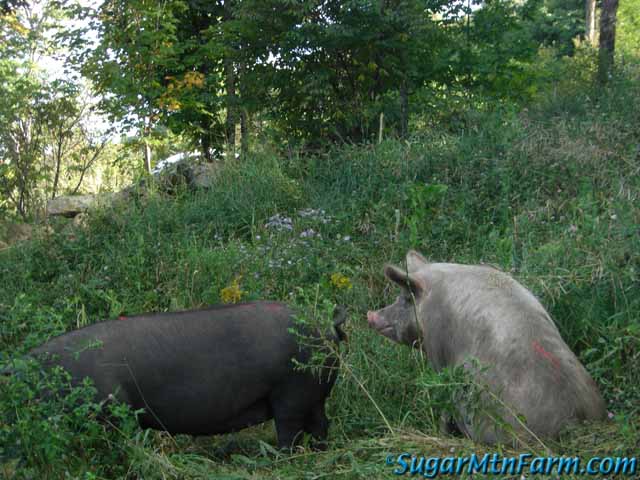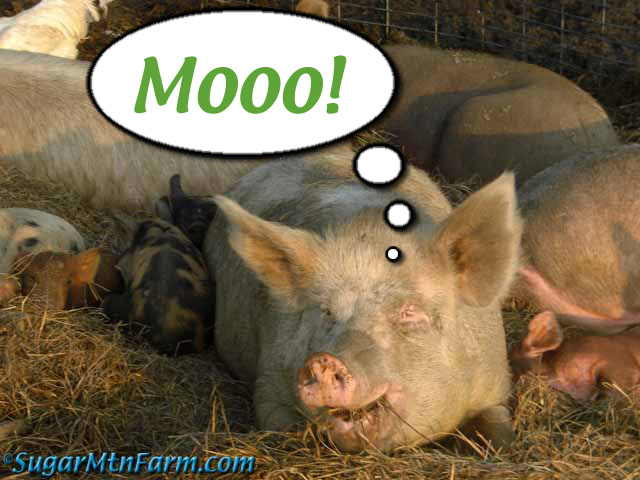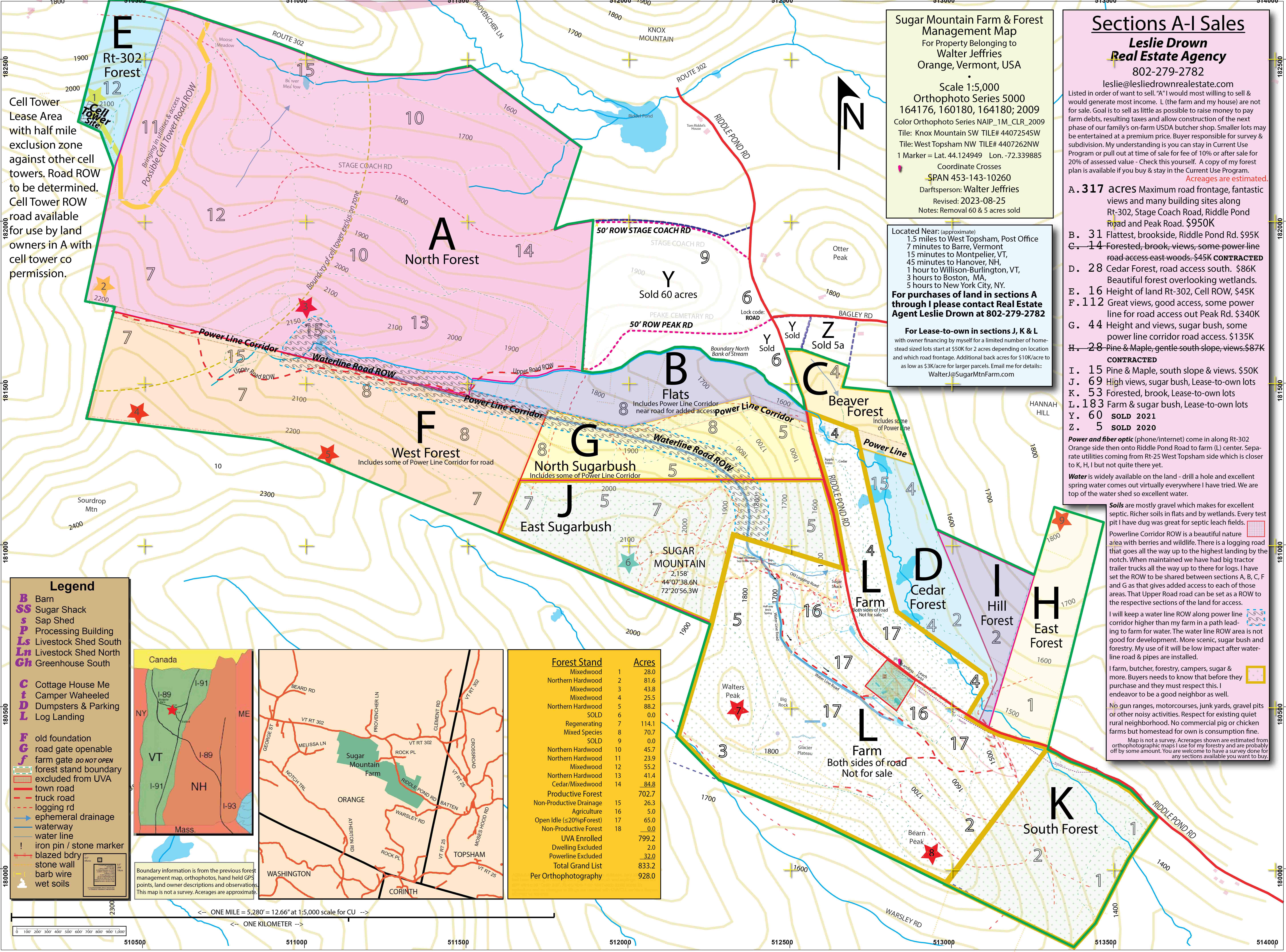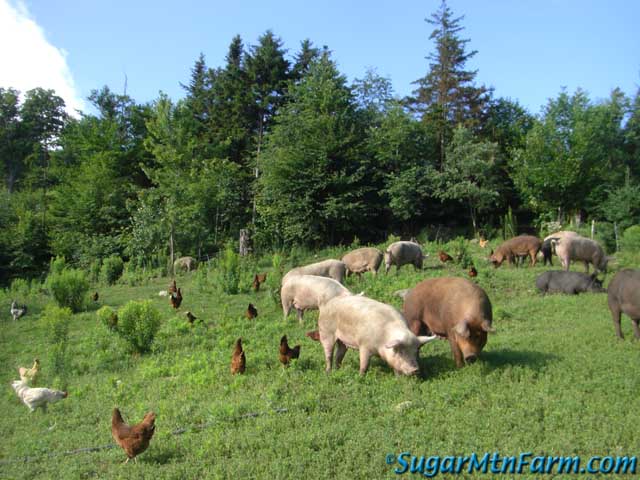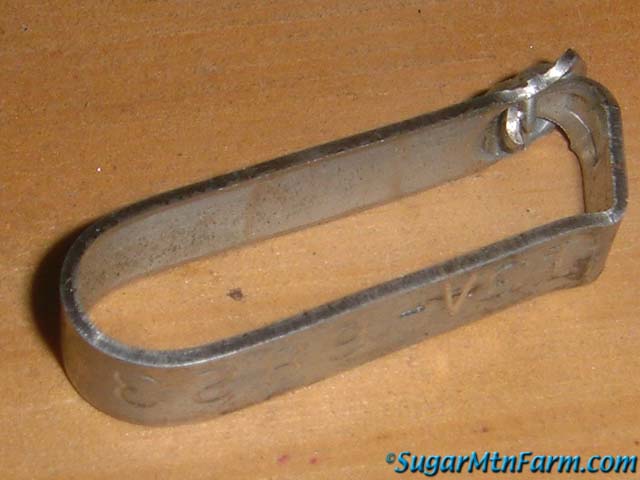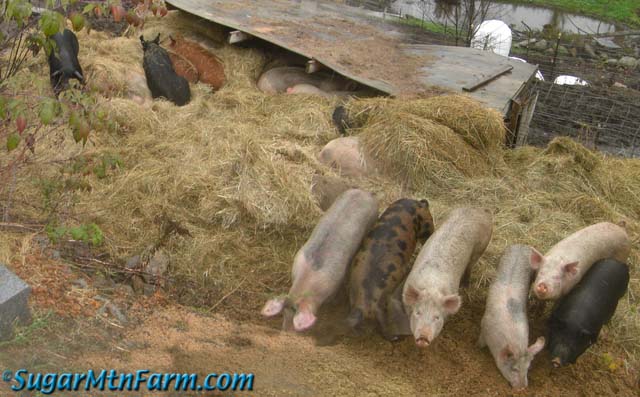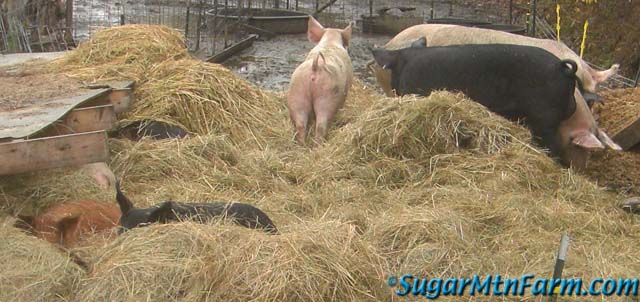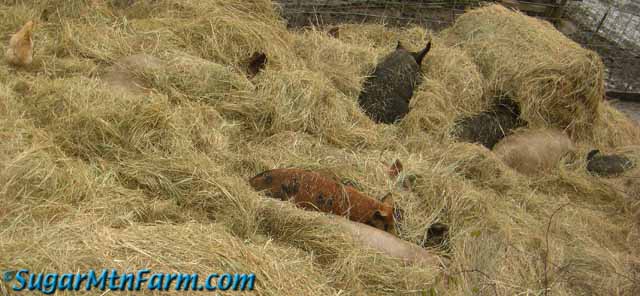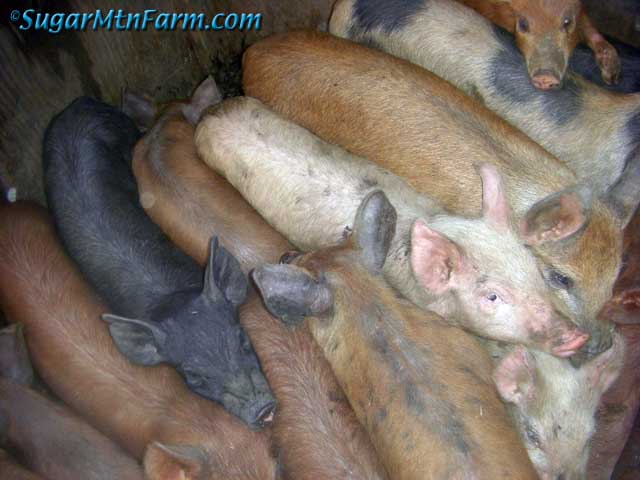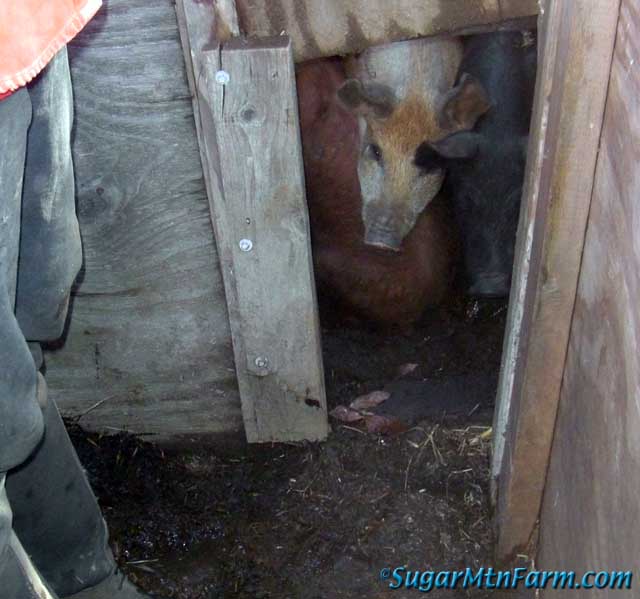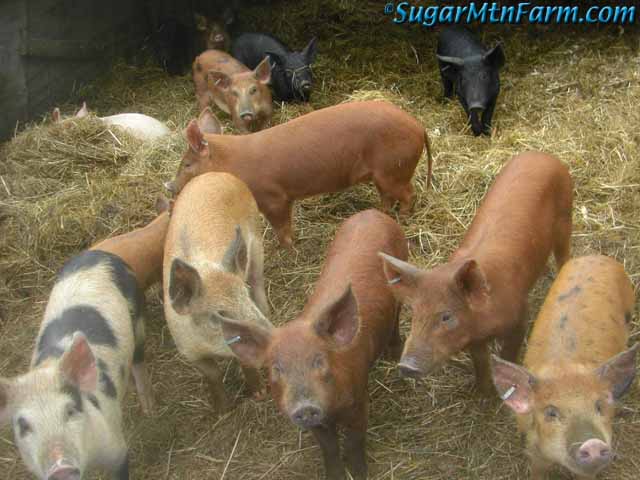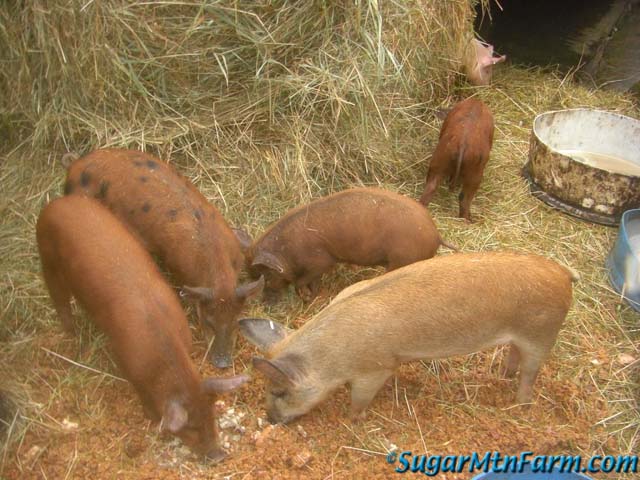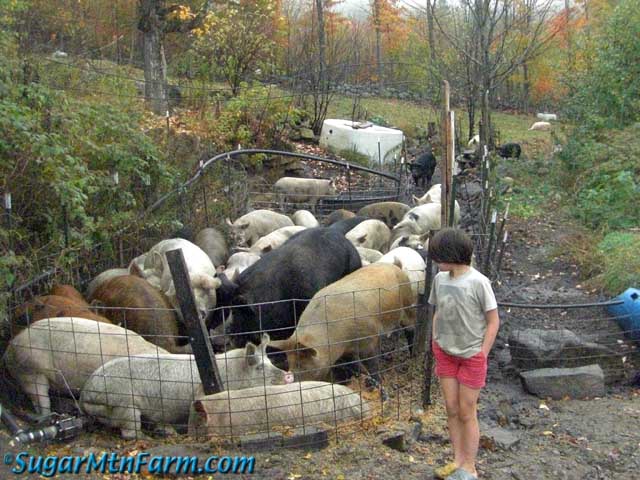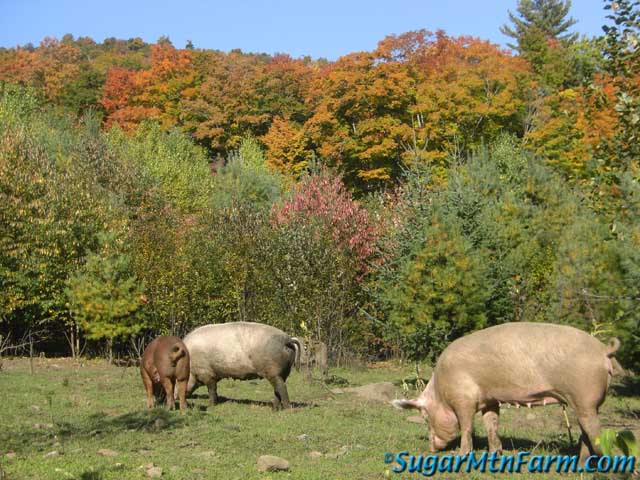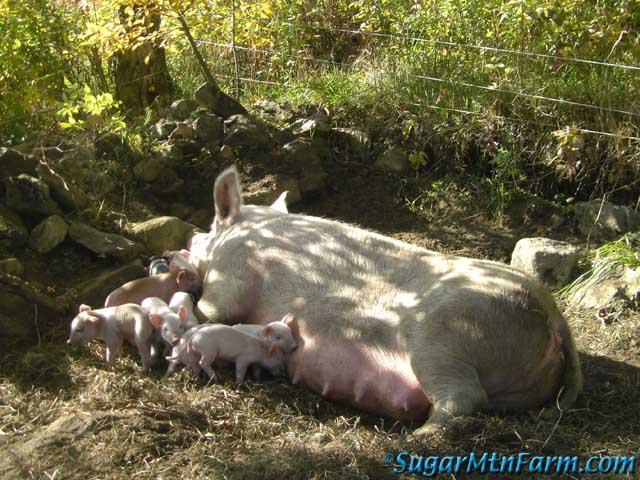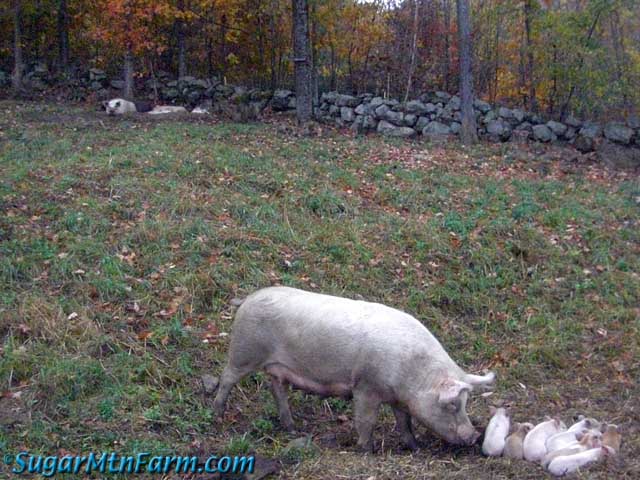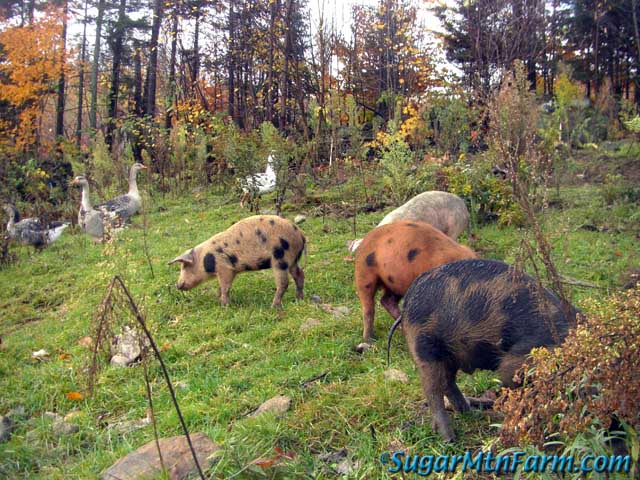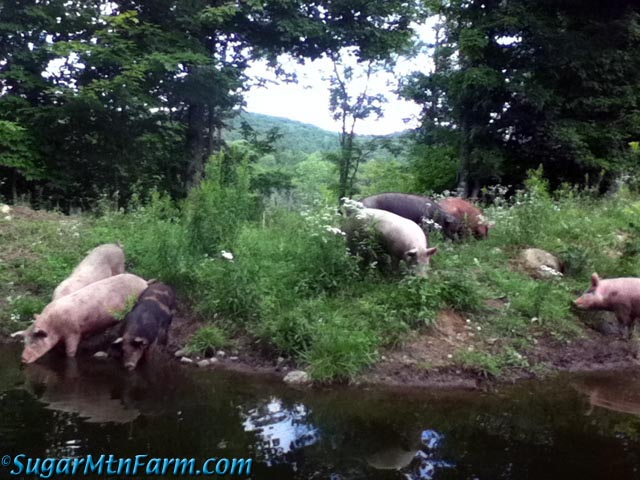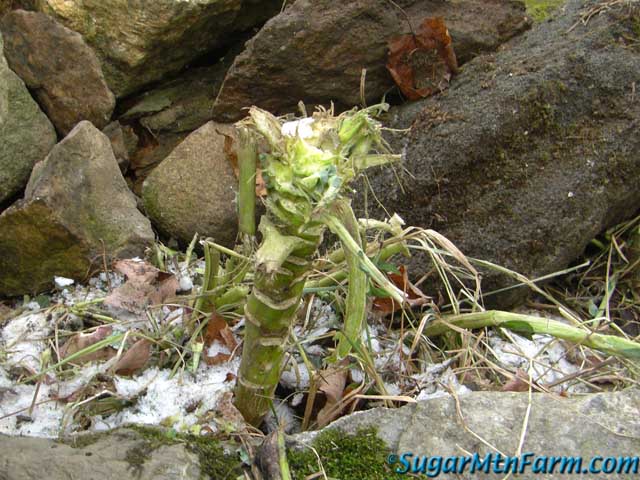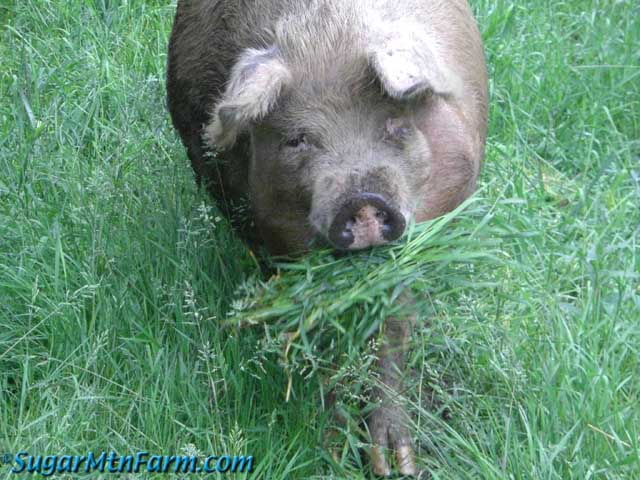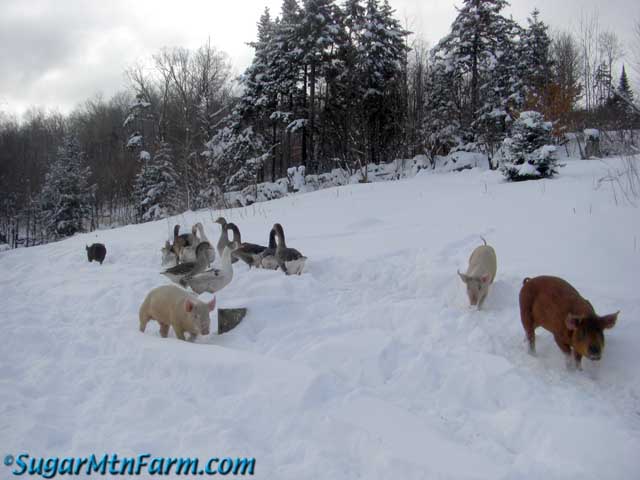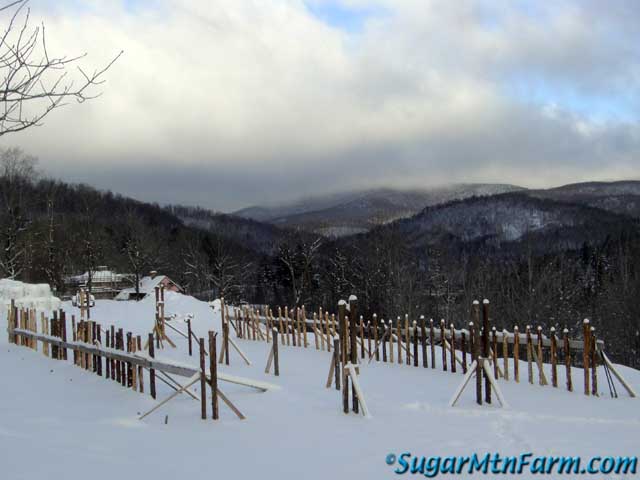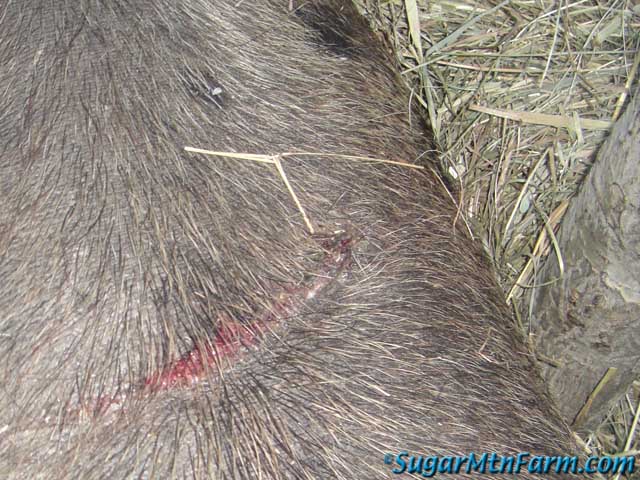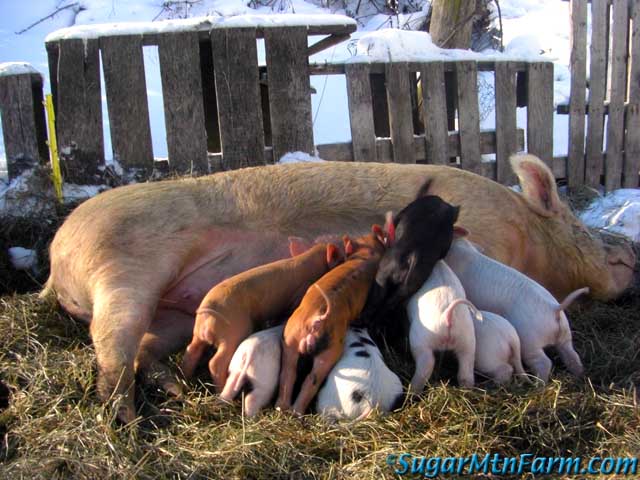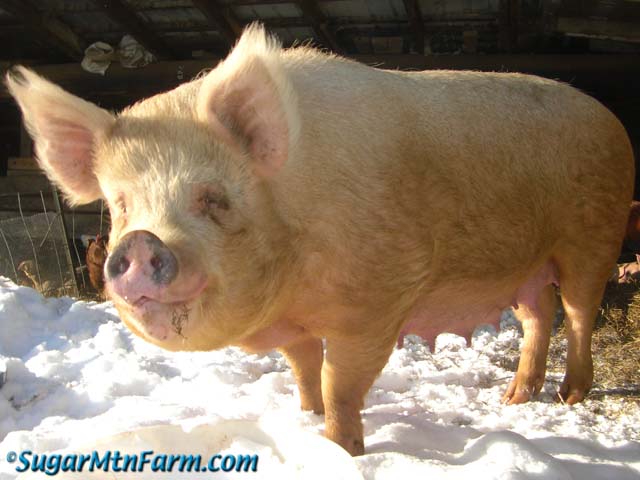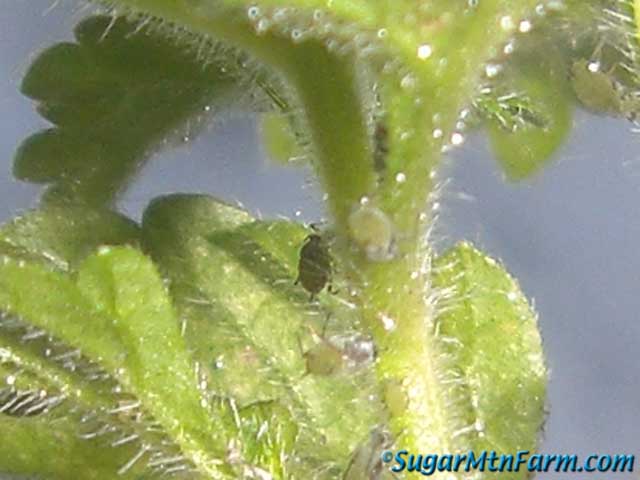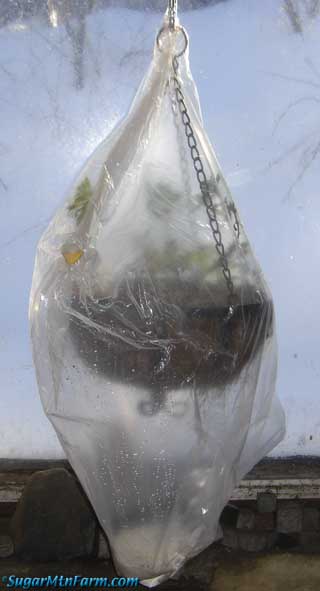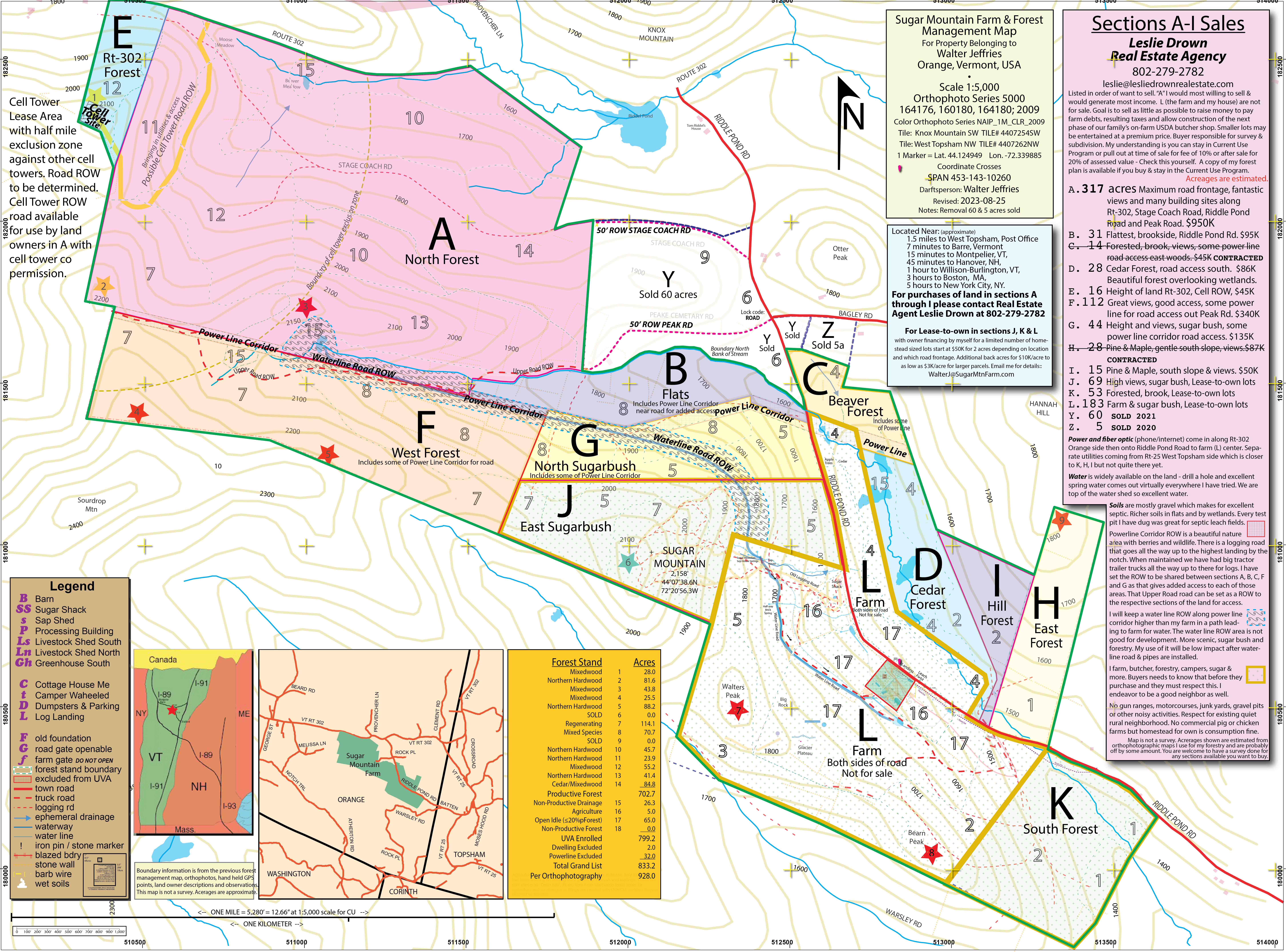![]()
Panorama of South Field Gathering of Pigs – Click on the picture to zoom larger.
This is the fall sleeping area for the south herd. You can see some hay bales we put out which draws them in to sleep closer after they graze for the day in the farther fields. If you look closely you can Ben, Will and Holly with sorting boards.
We just had a veterinarian come to our farm yesterday for inspecting and tagging pigs who are going for an out-of-state shipment. These are live breeders headed west to start a new herd. To ship across state lines they need paper work and health certificates, thus the veterinarian’s visit. All went well.
![]()
Ear Tag for Interstate Transport of Breeders
The vet said they were some of the healthiest pigs she had ever seen and was very pleased with what she saw. She was quite surprised when she found out that their diet is almost all pasture/hay plus a little whey, a little spent barley and a bit of pomace. She is used to the more usual grain feeding of pigs. (See the
Pig Page for more details about our pigs’s diet, feed, rotational grazing and how we manage them.)
Interestingly, she said that the most common problem she sees with pigs is young pigs getting moldy food because the food is in a feeder getting rained on. An important note for people who are feeding grain or commercial hog feed – keep the feed dry in storage and in feeders. Molds can produce mycotoxins which can hurt the animals, especially younger animals and those in utero.
![]()
Holly with Sorting Board in South Field Sleeping Area
The savannah type area under these saplings provides shelter but they are spaced widely enough that filtered sunlight gets down to the ground so grasses, clovers and brassicas grow. These make great farrowing areas.
Part of what the vet was impressed by with our herds was there were no signs of parasites and the pigs’s excellent condition. Our biggest
parasite controls are simply managed rotational grazing, healthy animals and winter. Cold weather and outdoor living kills parasites by disrupting their life cycle. I have come to suspect that even mildly cold weather can help with that. I also know that compost piles break the cycle as well – like the deep bedding packs we use in the winter. We also sporadically feed garlic which is an anti-parasitic. Whey may help as well since it lowers the gut pH. I will use Ivermec or Fenbendazole (SafeGuard), especially on occasion for weaners – a more in the winter thing when the pastures are less extensive. From talking with her I suspect that one issue people who do have parasite problems is that they’re in too great a density. She mentioned that problems arise with using the same soil year after year but we do that. The difference I suspect is that our pigs graze out over a large area on both a small and grand rotation.
![]()
Gilts and Boars on Strawberry Holding Area
This shipment involves mixing boars from two different herds. The boars are very evenly matched which makes mixing them an issue. The trick to getting everyone to get along is to have a party with lots of food, beautiful ladies, bedding and places to seek privacy. They worked their differences out quickly after a little shoulder shoving – boars’s equivelant of arm wrestling. The Blackieline boar won. In the coming days before they hop on the truck to go west they may tussle a little more but should be fine. This morning when I took this photo all looked well and everyone was getting along fine.
The vet was very impressed with the temperament of our pigs, that we were able to walk among the crowds of big ones, sorting, working with them, applying ear tags, sticking thermometers up their butts and such without any squeeze chute. As she noted, temperament is highly genetic. The knocker and the guy who unloads our pigs at the butcher each week have also both noted how well tempered our pigs are, something they appreciate. Good natured pigs are something we’ve been hard selecting for a long time and that has paid off. As I’ve said before: I eat mean people.
![]()
Waking up the next morning after the Big Party…
Another thing that the vet noticed was the fact that we don’t castrate. She was quite curious about that as visitors often are. She had some stories of her own to tell about pig balls and aggressive animals, of both sexes. I explained the factors that cause
taint and what minimizes it. We spent years figuring things out, tasting and selecting progressively older boars, testing our genetics and researching it before stopping castrations. At this point we haven’t cut pigs for years now and don’t get taint. A combination of good genetics, high fiber from pasture and good extensive grazing management.
![]()
14 Pigs Buried in Hay plus a Chicken on Top
She loved our
sorting boards. There are commercial versions, which are both expensive and heavy. Like her, we had experimented with making them out of plywood but those were even heavier. Then we hit on using 65 gallon plastic barrels which we cut the top band bottom off, split them and flattened them. Add some holes for handles and presto: inexpensive, durable, light weight sorting boards that are pig tough.
![]()
Tractor with Piglet Box docked to Loading Chute
To move the small pigs from the further area of the south field where we had gathered them we loaded them for a ride in the pig box which mounts on the tractor’s front forks. This makes for an easy calm transport across the mountain. This loading dock is what our van mates with each week for loading pigs to take to butcher.
I have come to suspect that the fact that we don’t castrate may be one of the factors that help with success on pasture because the boar pigs grow faster and are more efficient at converting feed to meat – both my own and experience and scientific research have shown this. Not castrating makes our boars reach market faster than the gilts and faster than barrows did back when we did castrate long ago. A fortuitous feedback loop.
![]()
Pigs in Pig Box
On a related note, the fact that we’ve spent so many years selecting for good temperament may also relate to this. Aggressive males might have higher taint levels and those are the ones I culled leaving the calmer ones who also were lower in taint. I had started culling for temperament prior to beginning work on the boar taint problem and that probably helped. Interlocking factors and balance.
The vet was very interested to learn about how we did the managed rotational grazing with pigs and how genetics, feed and management all interact with the taint and other management issues. We rotationally graze within herd fields and then those herds do grand rotations year to year so that in any year we’re only using about 40 acres out of the 70 acres of pasture that we graze.
![]()
Pigs Exiting Pig Box and into Loading Chute
Each boar group has it’s own territory. This means that typically boars grow up in a territory and don’t leave to cross over a different boar’s territory once they’re of size. We have found that this helps maintain the peace since the boars don’t feel their territory gets encroached by other males. They know their space. They’re secure there. Nobody invades them. They don’t invade anyone else’s territory. They’re aware of the others but are separated by no-boatman’s land. This is more like life out in the wild, a more natural setting. In the words of the great poet Robert Frost, “
Good fences make good neighbors.”
The sows move between the boar herds which is how we control breeding lines. This allows management of boars, genetics, optimal forage growth, parasite management and to keep open a larger area than we need at the moment so that when we want to we can easily expand. The numbers of pigs can shift dramatically at times with new births such as when 41 pigs were born the other week and about 40 are shipping out now between this order of breeders and our weekly deliveries for meat.
![]()
Breeder Gilts with Ear Tags
The veterinarian complimented us on how quiet everything was, how smoothly our family members worked together as a team. No yelling, just calm competence. We do this work every week, even multiple times a week, moving pigs around, weaning, sorting, loading for market and such. She got a big kick out of how capable our kids are, that for example Hope, age 11, went up to make lunch, no question of ability just smooth team work. These were perhaps two of the best compliments of the day.
![]()
Gilt Grower Pigs in Loading Pen
This photo shows a predominance of reds but the group also includes blacks, whites, spotted and fawns.
It was quite interesting to have someone, an outsider, who is very experienced in the field of agriculture as a vet and has seen many farms over the decades, come and see things here on our farm and be impressed. A different view on things we see and do every day and a kudos.
Pasture works. Over a decade of hard genetic selection works. Rinse and repeat, 52 times or more a year making things a little better, a little more fine tuned with every pass. If you want to get good at something, do it a lot.
Outdoors: 52°F/43°F Sunny
Tiny Cottage: 65°F/60°F
Daily Spark: I eat mean people. If you’re nice you may get to stay on the farm and breed. If your children are nice then some of them may get to stay and breed as well. Mean begets mean. Nice begets nice. I’ve found that niceness is highly heritable in chickens, sheep and pigs. I expect it is the same is in other species. Being nice is a good survival strategy.
†If you need a vet for small ruminants and pigs in northern central Vermont, email me and I’ll pass the vet’s name on to you. She was excellent to work with.
